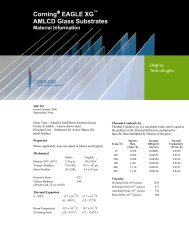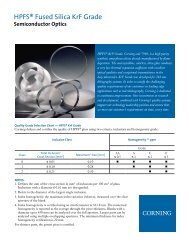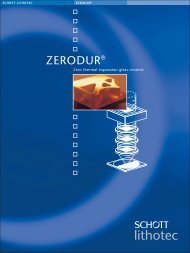Optical Silica Glass - Tosoh Corporation
Optical Silica Glass - Tosoh Corporation
Optical Silica Glass - Tosoh Corporation
You also want an ePaper? Increase the reach of your titles
YUMPU automatically turns print PDFs into web optimized ePapers that Google loves.
Impurity Level of <strong>Optical</strong> <strong>Silica</strong> <strong>Glass</strong> (Typical Value)Unit(ppm)Grades Al Ca Cu Fe Na K Li Mg OHES
DevitrificationWhen silica glass is exposed to high temperatures, the pure SiO2 structure changes from a glass state (amorphous) to a stablecrystalline state called cristobalite. This structural change is known as devitrification and generally occurs at temperatures over1,150℃ for clean clear fused quartz. Devitrification may also occur at temperatures below 1,000℃ in the presence of impuritiessuch as metal. The relation between the devitrification rate of clear fused quartz and temperature in various atmospheres is indicatedbelow.Gas composition Temp.(℃) Time(h) Degree of devitrification Devitrification thickness(μm)Air 1,300 72 Surface completely devitrified 250Dried oxygen 1,300 72 Devitrification of 50% of the surface 100~150Industrial nitrogen 1,300 72 Surface devitrified ーNitrogen(O2 and H2O removed) 1,300 72 No devitrification ーHydrogen(O2 and H2O removed) 1,300 72 No devitrification ーHandling PrecautionsCare must be taken to avoid direct hand contact with silica glass. The skin's natural salts contain alkali such as sodium, potassiumand other impurities that accelerate devitrification. All sources of metal contaminants should be avoided.As a further precaution, fused silica should be washed in pure or distilled water, then either air dried in a clean area or wiped dry withan alcohol-soaked clean cloth. For more rigorous cleaning, a very thin surface layer of the glass can be removed by etching, prior towater washing, in a 5% - 10% hydrofluoric acid solution.Usage Precautions* Always clean silica glass prior to use.* Dry product completely before using at high temperature.* Pay attention to devitrification due to atmospheric exposure.* Please refer to the thermal properties for your application. Fused silica can resist sudden heating and quenching, but it does haveits limits.* Always consider fused silica's very low thermal expansion when the glass is used with other materials to avoid failure due to thedifferences in thermal expansion.* Take caution during prolonged usage at temperatures approaching the annealing point.* Be aware that slow sagging may occur under high temperature.7








